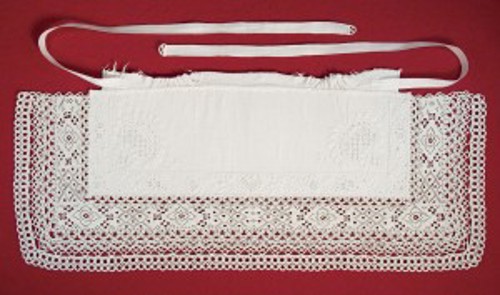Sewn laces
Here on this page, you will find examples of textiles that incorporate sewn laces.

”Hvidsøm” collar with a Hedebo edge
The collar was unpicked from a shift. The ”Hvidsøm” embroidery is divided into two parallel borders with a narrow chain of hemstitch in between. In this piece, fillings in the outermost flowers are sewn on the fabric, instead of being in the drawn fabric. All other fillings are made by drawing threads and embroidering cross-stitching over the remaining threads. In the lower narrow border, the flowers are embroidered in satin stitch, outline stitch, and chain stitch without fillings. The Hedebo edge is very tight and firm. It is embroidered with Danish buttonhole stitching in long rows with squared holes, which form the pattern. The collar is a typical example of a collar from around 1815 embroidered by an experienced needlewoman.
Please note
- The three rows of chain hemstitching are parallel to each other and do not continue along the collar’s ends
- The corner motif in ”Hvidsøm” on the reverse side has additional chain hemstitch, just enough to cover the width of the corner embroidery
- The small chain stitch flowers at the centre of the narrow border’s eight-leafed flowers
- The tulip motif in the narrow embroidered border



Collar with ”Baldyring” embroidery and a Hedebo edge
The collar may have been unpicked from a shift and seamed with a narrow hem. The embroidery consists of a large pomegranate-shaped ”Baldyring” in each corner. The squares of the ”Baldyring” are relatively small and filled with crosses and blanket stitch wheels. Between the pomegranates, a flower is embroidered in satin stitch and whip stitch, plus there are two leaf-shaped motifs with ”Hvidsøm” fillings of diagonal crossstitch, stiletto holes, and satin stitch. The needle lace consists of dense rows of Danish buttonhole stitching, and the pattern is made by the small holes in the rows.
Please note
- The three squares in the square cut work in the corner motif which help make a sharp corner
- The whipped hemstitch along the whole length of the collar’s embroidery. Traditionally, hemstitching was embroidered in horizontal lines without corners
- The innumerable picots on the edge of the scallops finishing the collar
- That the collar might have changed during the process, as the lace, apparently, was taken from another collar and attached to this with long overcast stitching as seen on the reverse side



Cut off collar embroidered with ”Baldyring” and surrounded with a Hedebo edge
The pattern on the two layers of fabric consists of a pomegranate in each corner and a narrow, tightly stitched border. A number of stiletto holes can be seen both alongside the vines and in the centre of the flowers, and also in the corner motifs on the narrow border. Between the two borders is “the chain” of hemstitch. The Hedebo edge consists of both a solid and an open part. In the solid part, rows of Danish buttonhole stitch alternate with larger and smaller square spaces. The open part of the lace contains a row of Hedebo rings. This may mean the collar is either a late ”Baldyring”, or that the collar’s open part was added later when larger collars became fashionable in the middle of the 19th century.
Please note
- The chainstitch flowers in the large corner motif and around the ”Baldyring” fillings
- That the square spaces in the narrow border are filled with a cross bar of threads which is repeated in the solid part of the lace
- The small scallops at the end of the binding ribbons
- The tight row of picots finishing the small scallops




Collar with cut work Hedebo and a Hedebo edge
The collar is full of detail and dominated by two large tulips on the sides. Around the tulips are round and oval cut spaces with beading loops and crosses. The oval and square cut spaces around the centre are filled with beading loops with many picots. The single motifs are connected with small vines and leaves embroidered in satin stitch. The lace consists of 34 half rosettes made up of seven Hedebo rings with scallops, and filled with points and cross threads. The collar’s form and composition suggests that this collar is from around 1890.
Please note
- The right angled frame of a single and double row of squared ”Baldyring” spaces. The row finishes neatly at the edge
- The filled ”Baldyring” row in the collar’s centre, above the half rose and the two squares
- The row of tilted scallops along the inner side of the collar, which indicates that the lace was embroidered as a single unit, and attached later to the collar
- The many whole and half buttonhole scallop wheels



Collar with cut work Hedebo and a Hedebo edge
The pattern composition is vigorous, unrestrained, and a stylish mixture. The needlewoman used all the available shapes of cut work Hedebo fillings she could think of. The many rosettes consist of round, leaf-shaped, and heart-shaped cut spaces with fillings combined with stiletto holes. The needle lace consists of beading loops, K border and points, some of them with picots. The embroidered lace consists of tilted scallops and a row of large ‘wheels’. Inside the wheels, a so-called ‘spider’ is embroidered. The collar is likely to be from around 1900.
Please note
- The stiletto holes and the satin stitching are embroidered with somewhat thicker cotton thread than the rest
- The rosettes of the needle lace are made of an unusually large ring in the middle, with 8 points on the edge connected by beading loops
- The rosettes are sewn to a row of tilted scallops at the collar’s edge, and are connected at the ends by a row of scallops
- The tightly filled leaves in the scallops on the sides, and along the straight edge at the bottom


